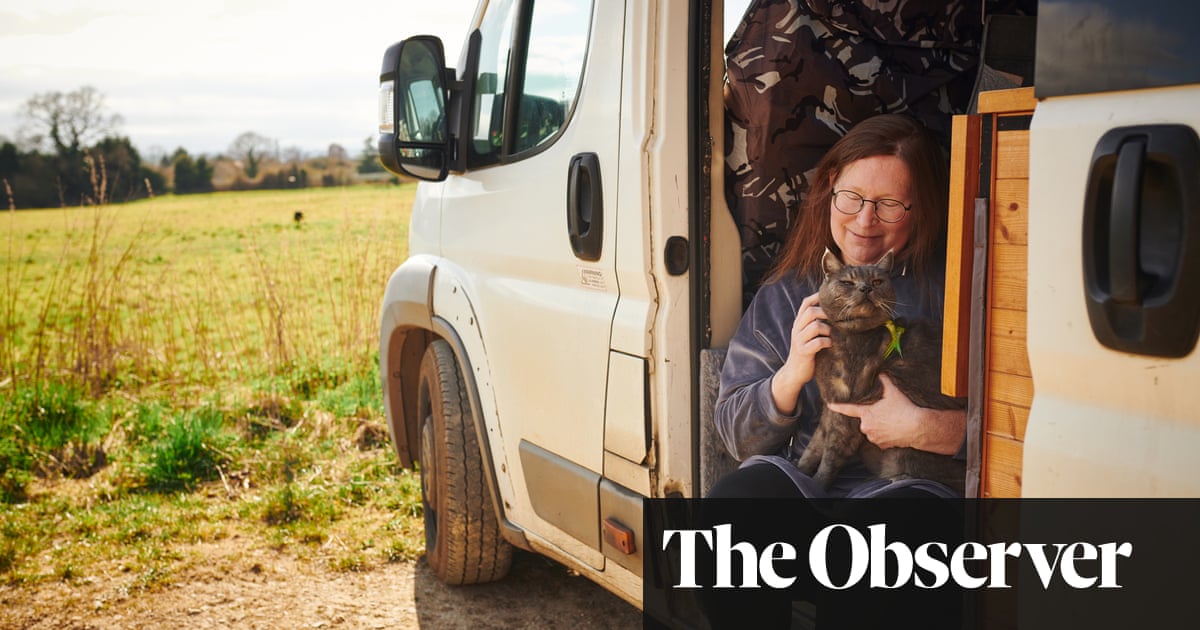Two years ago, Chris and Jenna Humphrey moved from their urban house to their rural dream. “We wanted our kids to have this,” says Chris, gesturing at the green fields surrounding their cottage, which sits in splendid isolation in the south Norfolk countryside. “It was pitch black when we moved in and the first morning the kids woke up they looked out of the window and there were three deer walking across the field. It was magical for them.”
They are settled now. Their older children, six and eight, go to the village school and Jenna, a special needs teacher, is nursing their youngest at home. “We fell in love with the house, because every window has such a lovely view. We thought the children would grow up here and never get bored. My little boy is constantly getting the binoculars out, birdwatching from the window.”
Now there’s a blight on their wide horizons. On three sides of their home, the fields are set to be filled with solar panels for one of Britain’s growing number of huge solar farms – “solar factories”, say opponents. “I’m all for solar,” says Chris, a software developer. They have panels on their garage roof. “It just seems criminal that hundreds of new houses are being built down the road and none have solar panels, when they would benefit households. These solar farms seem like corporate thinking to generate profits – they are putting profits before the countryside, food production and the environment.”
The solar farm proposed for these fields is one of dozens of 500MW projects – far bigger than most in Britain – under development. Britain’s solar contribution to the National Grid is still a modest 4.89% of electricity in 2023, compared with 12.05% in Germany (where just over a quarter of that 12% is provided by solar farms). The country needs a lot of new solar if Labour are to hit their ambitious target of decarbonising electricity supply by 2030.
Solar is the cheapest and easiest renewable energy to build. Chinese-made panels now cost just 10 US cents per watt; you could build a fence with them more cheaply than with ordinary fencing materials, joke industry analysts. Solar farms are clean, usually disappear behind hedges and leave no lasting damage; their power is reliable and safe. It was the least offensive form of renewables. Until now.
“The more you learn, the worse it gets,” says Chris of the solar developments on their doorstep. In Westminster, Labour is said to have a slogan: “Smash the Nimbys!” In the provinces, communities are discovering that the government’s 2030 target trumps old and trusted ways of doing things. Very few regulations govern solar farms. They can be put on the best grades of farmland. There are no minimum distances between the panels and people’s homes. And worst of all, say locals, the big new schemes, such as the one outside the Humphreys’ windows, qualify as nationally significant infrastructure projects (NSIPs). This means solar applications bypass local planning authorities and local opinion. They are decided by national planning inspectors and, ultimately, energy secretary Ed Miliband.
Many locals in south Norfolk didn’t pay much attention to the leaflet that dropped on doormats several months ago. It was actually a proposal for East Pye Solar, a 500MW farm on 2,700 acres dotted across a nine-mile swath of countryside. “If you peeled it open, it showed a map of our bit of Norfolk with this massive solar farm on it,” says Annetta Berry, an art historian who moved her family from Hackney in London to a Tudor farmhouse beside an ancient wood a few years ago.

At first glance, south Norfolk ticks every box for a solar developer: it is flat, rural, relatively unpopulated and doesn’t feature any national parks or many conservation areas. Up close, however, this landscape is unexpectedly intimate and distinctive, with small fields, ancient hedges and scores of historic houses built by yeoman farmers that have not been gentrified into uniformity. Unlike much of southern England, it is still endearingly rural: there’s a ford across a B-road, field-side adverts for “cheap haylage”; some old houses, including Berry’s, are not even on mains water. Her water comes from their own well; she’s worried about contamination when panels are driven into land supposedly protected for her drinking water.
Since learning about East Pye, which has been conducting consultations in packed and uneasy village halls, Berry and others have discovered three further large solar farms earmarked for the area. “Three months ago, we were living in a peaceful, unspoilt, rural community. Now it feels like we’re under attack. Everything you thought was normal in life has been turned on its head,” she says.
For Berry, it’s not just the upheaval of this historic landscape. Her political beliefs are being challenged, too. “I always voted Labour. I always thought Labour were sensible, they looked after working people. All this trying to serve big business and screwing everyone over was an entirely Tory activity,” she says. Her vote in rural Norfolk was usually wasted. “I was amazed and delighted when we got a Labour MP [in the 2024 general election]. I thought, people around here will now see what it is to have a Labour MP. But it’s been horrific. I feel like apologising to everyone.”
It’s difficult not to sympathise with the very direct way new solar fields will affect some unlucky people. East Pye Solar promises at least a 50m buffer from homes, but the tracker panels – which follow the sun – will be up to 4.5m high. There is no compensation for people who might lose businesses or house value. Roy and Heidi Martin have spent the last three years converting their disused barn into two immaculate holiday lets overlooking fields that will be filled with panels. Roy believes their business will be completely unviable. “People come here for a quiet retreat. It’s the last thing they are going to want,” he says. “I’ve put everything into this – my life savings, two years of every penny I could earn, and what are we going to be left with?” he says.
A local estate agent has suggested that the value of the worst-impacted houses could fall by 30%. If that happens, Chris and Jenna Humphrey will be in negative equity, their mortgage will be larger than their house’s value. A 2023 peer-reviewed study found that UK house values dropped by an average of 10.2% if less than 750m south of installations greater than 10MW (properties to the south may be more affected because of panel glare), but they will be 50m away. “It might not impact the property as much as the estate agent is saying,” says Jenna, “but we can’t gamble. It would be too much of a loss.” They say they will be forced to sell, and hope to claw back their losses through the legal “blight” process in which the government can choose to pay individuals for value lost to major new developments.

Opponents of solar farms make two main arguments: why not put them on rooftops? And what about food security? “If I ruled the world, I’d have solar on all new buildings,” says Jenny Chase, lead solar analyst for BloombergNEF. But, she explains, “utility-scale” solar – on fields – is still required because that generated on rooftops is expensive at scale. For instance, a 50MW solar farm might require one set of agreements with a single landowner, the same amount of paperwork as a single half-a-megawatt rooftop installation. “It is more difficult and expensive to build rooftop solar than utility-scale solar because you’ve got a lot of stakeholders to coordinate, which is why solar developers prefer to find a big site and maintain them more effectively in one place.”
These developers liken rooftop solar to growing your own food: even if everyone had an allotment, Britain would still need to grow and import food at scale. Even so, the bulk of British solar is still rooftop: according to Chase, 0.8GW of UK utility-scale farms were commissioned in 2024 verses 1.6GW of residential and commercial (rooftops).
And what about losing food-growing land to solar? “A lot of the land we’re taking out of production is land that doesn’t make money. It might produce some low-grade feed for cattle. If it made money, we’d carry on farming it,” says one of the farmers who has signed up to lease fields to East Pye Solar, and wishes to remain anonymous. He says he is losing money on his wheat [for cattle feed] fields this year; solar will net him upwards of £1,000 per acre per year, with payments linked to inflation. “People like to think the countryside never changes and always looks beautiful,” he says. “The countryside has to make money like everywhere else. A lot of people support the solar farm. They’d rather see that than houses or wind turbines. People are much more positive than is being made out.”

Stuart and Rebecca Mayhew are regenerative farmers who have not signed up to East Pye Solar but their land is earmarked for a cable route. If they don’t agree, it can be compulsorily purchased. They are not happy about the disruption, or potential damage to their topsoil. But they feel the what-about-food-production? critique of solar farming is misguided. “Farming’s complicated,” says Stuart. “That 2,700 acres [for East Pye Solar] feeds hardly anyone. It’s all feed-wheat for cattle, and maize for biodigesters.” He does a quick calculation: he reckonsthat sheep grazed beneath the East Pye Solar farm could generate £1.5m of income – so solar fields could potentially produce more food than the open farmland currently does.
The Mayhews have their own small solar field sown with a wildflower mix which boosts biodiversity. Giving the soil beneath the panels a 30-year rest also hugely benefits soil health and soil biodiversity. “We’ve seen 70, 80, 90% biodiversity net gain on our projects without trying, quite frankly – just taking it out of agriculture,” says Dave Elvin, chief operating officer at Island Green Power, the company behind East Pye Solar. A scientific study has found bat activity diminishes on solar fields and there are fears for populations of rare barbastelle bats in south Norfolk but, if done well, solar farms look like an opportunity to boost nature. Nevertheless, the Mayhews are critical of another solar farm near them which is a field of agricultural weeds in summer. “There’s no betterment for that land,” says Stuart. “There’s no wildflowers or sheep under those panels. That is an appalling example of solar.”
Elvin has been developing solar farms for Island Green for more than a decade. Generally, he says, discontent subsides once a solar farm is built. “People realise the world hasn’t ended, it’s some panels behind a hedge,” he says. He says Island Green undertakes a two-stage consultation process because they want to hear everyone’s specific complaints so they can tweak the design and mitigate problems. Typically, panels are moved further from houses, or screened, or adjusted so there’s no glint and glare. I ask about the impact on Roy Martin’s Airbnb. “I understand the fear, and we can talk to individuals about whether there’s things we can help them with.” Compensation? “I wouldn’t put it under the compensation banner,” says Elvin but he cites a country house hotel overlooking a solar field. It was given free panels to reduce its £1,500-a-month electricity bill; it’s still thriving, 10 years on. “It’s for the government to set the regulatory framework,” he says. “It’s not a palatable thing to say but planning law basically says nobody’s entitled to a view.” Would you buy a house beside a solar farm? “I’m surrounded by houses. I’d love to be next to a solar farm where I haven’t got any neighbours to annoy me and vice versa,,” he says.

No solar developer seeks to antagonise people, argues Elvin, and the industry has a good reputation for tweaking designs in response to local feeling. But many in south Norfolk are fearful of the apparent absence of planning regulations. Jill Guy lives in a picturesque small valley; panels are earmarked for the low hill beside their home. Guy takes me for a drive through the surrounding countryside. Most fields are owned by a local farmer. Many are not overlooked by any houses at all, and yet the farmer and East Pye Solar have decided that the panels will loom directly over Guy’s house. “We’re trying to be pragmatic but I’ve sat and cried,” she says. “He’s got all these fields and he can just go, ‘Oh that one there for solar’. These decisions shouldn’t be made by individuals. All of these communities – we are powerless, we have no rights. If we play nicely with the solar company perhaps they’ll give us another 10 metres or hedging. That’s not equitable. If Ed Miliband wants 10,000 acres of solar panels in Norfolk, Norfolk county council should be able to identify land and consult with people about the best places. That’s democracy. There’s no regulation, no proper planning gone into any of this.”
East Pye’s solar fields will straddle footpaths, including the Boudicca Way, and there’s something of the warrior queen about Kay Mason Billig, leader of Norfolk county council, as she stands in her office overlooking the fields of south Norfolk. Recently, six major new proposals have emerged across the county, each one far bigger than anything before. It’s a “gold rush”, says Mason Billig. Developers are competing for grid connections, particularly linked to a new Norwich-Tilbury pylon line which has not yet got planning permission. The region’s green and pleasant land is being sacrificed so that Londoners can “plug in their Tesla in Camden”, declares Mason Billig, who is originally from south London and whose house has 18 solar panels on the roof.
She argues that the region already produces far more energy than it uses, and so renewable solar power is, in effect, being exported to other parts of Britain. And unlike previous eras, when coal-fired power stations near coalmines also produced local jobs, there are no obvious upsides for locals. “It feels like a betrayal. Norfolk is a net contributor to the UK economy and yet we get very little in return except to be used like some sort of commodity – an electricity factory. We’re very upset that London politicians don’t cherish what everybody else thinks is a beautiful place. It’s not that we don’t want clean, green energy. It’s just the proliferation of solar farms and the lack of control about where they go, that’s the issue.”
Alongside council leaders in Lincolnshire, Suffolk and Essex, Mason Billig is taking legal advice. One legal avenue might be to challenge schemes such as East Pye being classified as NSIPs. Ideally, she’d like local councils and people to be given a real say. Could East Pye be tweaked and made acceptable? “Honestly, you can’t mitigate this. It’s too big, it’s too much, it’s just not right.”
What will Norfolk look like in 2035? “It’ll be very shiny. There’ll be a lovely glint,” says Mason Billig with grim irony. “You’ll be able to see it from London – you’ll see the glow in the distance and you’ll think, ‘That’s where my power is coming from.’”

.png) 3 months ago
27
3 months ago
27













































